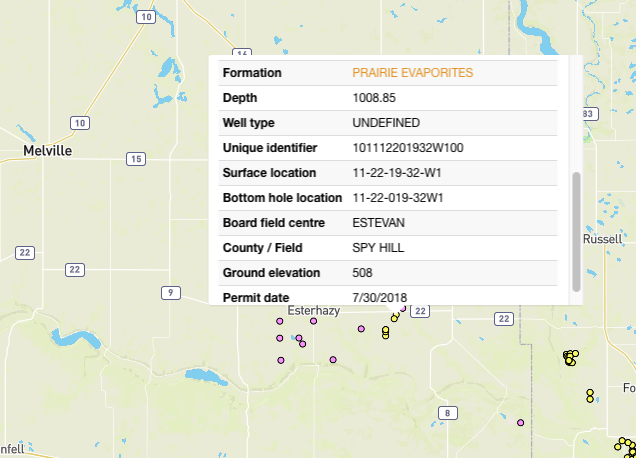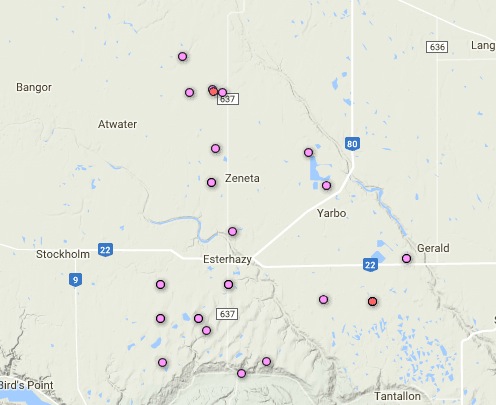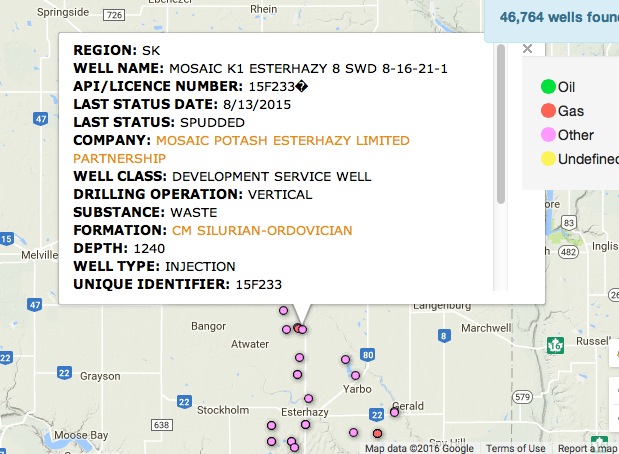Numerous “undefined” directional wells (licenced July 30, 2018) were recently drilled in the area of the 4.1M earthquake. Refer to the yellow dots in the follow maps:



Catastrophic Failures of Underground Evaporite Mines by Jeff Whyatt, Mining Engineer, Floyd Varley, Acting Branch Chief, NIOSH – Spokane Research Laboratory, Spokane, WA, NIOSHTIC2 Number: 20034347, in Proceedings of the 27th International Conference on Ground Control in Mining, July 29 – July 31, 2008.
CASE STUDIES: Saskatchewan Potash Mining Seismic Events (1962-1989)
Some evaporite mines are a significant source of mining induced seismic events.
Hasegawa et al. (8) reviewed large seismic events produced by mining of potash in Saskatchewan under 900 to 1000 m of overburden. These deposits lie in a thick sequence of halite and anhydrite known as the Prairie Evaporite, which is overlain by roughly 40 m of strong, dense Dawson Bay limestone (Figure 1).

Between the onset of mining in 1962 and the end of 1989, 21 mining induced seismic events with magnitudes of 2.3 to 3.6 were recorded. Horner (9) attributes these events to “brittle failure or sudden rupture” in the competent carbonate rock of the Dawson Bay limestone. Rockburst damage has not been reported but noise, movement of air (minor air blasts) and falls of loose roof rock have.
Hasegawa et al. suggest that salt overlying mining provides protection by attenuating dynamic shocks.
Sepehr and Stimpson (10) created a simplified numerical model of strata failure, inspired by a potash mine near Saskatoon, Sakatchewan that had produced seven events with magnitudes of 2.3 to 3.5. The model simulated mining of evaporite beds under 1 km of overburden. They found failure propagation into the Dawson was “so rapid and extensive… that numerical convergence is not achieved, signaling a structurally unstable situation.” They concluded “such extensive and rapid brittle failure would certainly induce significant seismicity.” That is, they interpret failure of the solver algorithm in their finite element program as indicating physical as well as numerical instability.
****
The 4.1M earthquake near Esterhazy was first reported by USGS, later by Natural Resources Canada:


USGS:

From USGS: M 4.1 – 17km E of Esterhazy, Canada
- 2019-08-16 02:30:46 (UTC)
- 50.676°N 101.839°W
- 5.0 km depth
- https://earthquake.usgs.gov/earthquakes/eventpage/us600055rx/executive
USGS Community Internet Intensity Map as of 1:30ppm, Aug 16, 2019, 15 responses:

USGS Community Internet Intensity Map as of 10:30pm, Aug 15, 2019, nine responses:

8 Felt Reports as of 10:27pm, August 15, 2019

‘A good rumble:’ 4.1 magnitude earthquake rattles Esterhazy area Thursday evening, 4.1 magnitude quake was centred approximately 17 kilometres east of Esterhazy by Ethan Williams, August 16, 2019, Star Phoenix
Les Salkeld immediately knew an earthquake was happening when he felt the ground rumble underneath him Thursday evening.
“They’re common,” he said, adding the last one he felt was in the spring.
Salkeld was in his trailer home in the village of Gerald — approximately 245 kilometres east of Regina — last night around 8:30 when the earth shook.
According to the US Geological Survey, the 4.1 magnitude quake was centred about 17 kilometres east of Esterhazy and had a depth of about five kilometres.
Salkheld said the epicentre was essentially right under his house.
“It was a good rumble,” he said. “It was one of the better ones.”
Other than his power being out for a couple of hours, he said his home didn’t suffer any damage.
Salkeld said many people mistake earthquakes in the area for passing trains and don’t often feel them because they’re very small.
The quake was also felt in nearby Esterhazy, located just over 20 kilometres west of Gerald. “There were some individuals that said they felt a little bit of a shake,” said Esterhazy Mayor Grant Forster Friday morning. “But, at least in town, we didn’t see anything in terms of damage.”
Forster said even though the area is prone to minor quakes, Esterhazy doesn’t have a specific contingency plan it can implement — other than its regular emergency management operations plan — in the event of a larger seismic event.
… SaskPower spokesperson Joel Cherry confirmed that the power went out in the area shortly after 8:30, but was back on around 10:35 Thursday evening. He said almost 8,400 customers were affected by the outage.
He said no infrastructure was damaged, but the loss of power originated from a gas relay — a device used to detect gas leaks or pressure changes — at SaskPower’s switching station near Tantallon, about 30 kilometres southeast of Esterhazy.
“When the vibration from the earthquake happened, basically the gas relays tripped off,” said Cherry. “So that turned the power off.”
He said three of the four transformers were tripped off as a result. The system is then locked out when this occurs so that it isn’t re-energized in case there’s a gas leak or other serious incident.
“We have to get out there, visually inspect it … and then manually reset it to get the power going again,” said Cherry, adding there was no damage reported by inspection crews.
The quake’s epicentre was very close to Mosaic’s K2 Potash Mine. Mosaic spokesperson Sarah Fedorchuk confirmed the mine suffered a loss of power for a couple of hours and the approximately 120 employees in the mine at the time were mustered and accounted for shortly afterward.
Fedorchuk said there was no damage from the quake and no major impact to the site’s operations even though work had to be stopped during the outage.
She added it’s not unusual for smaller seismic events to occur in that area.
“Due to the ground makeup of this particular region, it is prone to these types of seismic activities,” she said.
… Previous earthquakes in that area of the province that have reached a similar magnitude include a 3.8 magnitude quake centred 32 kilometres southeast of Yorkton in September of 2016 and a 3.7 magnitude quake that struck six kilometres outside of Esterhazy in March of 1988.
The strongest earthquake felt in Saskatchewan was in May of 1909, when a 90 second, 5.5 magnitude quake rattled the southern portion of the province causing minor infrastructure damage.
Earthquake knocks out power in Saskatchewan communities by The Canadian Press, August 16, 2019, Canadian Underwriter [insurance companies getting nervous?]
Power cut when minor earthquake shakes southeastern Saskatchewan by The Canadian Press, August 16, 2019, City News
ESTERHAZY, Sask. — A small earthquake shook parts of southeastern Saskatchewan Thursday night, knocking out power and rattling homes in the region.
… SaskPower says electricity was knocked out in seven communities, including Esterhazy, Whitewood, Moosomin and Rockanville, although the Crown utility didn’t immediately know if the outage was related to the earthquake. Power was restored around 11:30 p.m.
Grant Moore, who owns an acreage southeast of Esterhazy, says the shaking lasted between three and five seconds.
He says no one in his family was hurt, but they will spend today looking for any damage to their home
“It shook the chairs and the couch in here and the chimes in the door were shaking and rattling,” said Moore.
“The kids were scared and my mother’s rocking chair started rocking.”
Moore said he can recall a similar earthquake in the area two years ago.
4.1 magnitude earthquake shakes Esterhazy and area by Global News, August 16, 2019
A small earthquake struck just east of Esterhazy Thursday evening.
The United States Geological Survey confirms a 4.1 magnitude quake hit the region 17 kilometres east of the town at 8:30 p.m.
The epicenter of the quake was located just outside of Mosaic’s K2 Potash mine.
SaskPower reports several communities in the area including Esterhazy, Whitewood, Moosomin, Rockanville Wapella and Tantallon experienced power outages, but power was restored a few hours later.
It is unknown at this time if the earthquake is responsible.
‘It was scary’: Earthquake hits Esterhazy, Power gets knocked out; miners took refuge underground by CBC News, Aug 16, 2019
The Esterhazy, Sask., area was hit with an earthquake Thursday night.
The U.S. Geological Survey says the quake, which rocked the area around 8:30 p.m. CST, was 4.1 in magnitude, and was centred about five kilometres below the surface. The epicentre was about five kilometres from Mosaic’s K2 potash mine at Gerald, Sask.
A relative of one miner tells CBC the workers immediately went to refuge stations as a precaution.
The area was also hit by a power outage within minutes, according to SaskPower. The utility service said there are signs that the earthquake affected the transmission system in the area, but the utility is not sure how seriously.
The lights went out around 9 p.m. CST in Esterhazy, Whitewood, Moosomin, Rocanville, and a number of other surrounding communities. Power was restored about two and a half hours later.
Tracy Moore was playing with her grandchildren when her Tantallon-area farmhouse started shaking, for about three to five seconds, and the power went out. Moore said the children screamed and cried.
“The youngest thought she was going to die. It was scary for them,” Moore said.
Her family didn’t want to head downstairs in the dark on Thursday night to see if the quake damaged the concrete, so she will find out on Friday if anything was damaged.
Earthquakes common in area
The community has been struck by earthquakes before. In the fall of 2016, there was an 3.8-magnitude earthquake. There have been 17 earthquakes around that magnitude in the Yorkton-Esterhazy area since 1981.
CBC previously spoke to a Andrew Frederikson, a seismologist at the University of Manitoba. He said the high prevalence of earthquakes in the area is due to the makeup of the earth in the area, not necessarily because of potash mining, although that can contribute to it.
Frederikson said potash dissolves water in the soil in the area, which can make a lot of changes to the water table and cause earthquakes. [And many injection wells, see below for maps. Why are authorities not talking about the known earthquake risks from injection wells? Why are so many authorities denying the obvious?]
Earthquake hits near Esterhazy, Sask. by CTV Regina, August 15, 2019 10:02 PM CST
A minor earthquake has been reported near Esterhazy, Saskatchewan.
The United States Geological Survey confirmed the 4.1 magnitude earthquake happened 17 kilometres east of Esterhazy at 8:30 p.m.
According to SaskPower, power is out for the community of Esterhazy, Whitewood, Moosomin and Rockanville, but it is unknown if the outage is related to the earthquake.
Refer also to:
2019: Terrifying! Injected oilfield wastewater may trigger earthquakes for ‘decades.’ More terrifying: Percentage of high-magnitude quakes felt at the surface increases with depth of waste injected & may create greater magnitude quakes years after injection rates decline or stop.
2019: Earthquake felt Sunday morning (March 10) near Rocky Mountain House, Alta., Excellent well-researched comments by Diana Daunheimer, Alberta farmer and mother of two, including on injection wells causing earthquakes
2018 Study: Oklahoma’s induced seismicity strongly linked to wastewater injection depth
2016: 3.8M earthquake location changed from Yorkton to Esterhazy, Saskatchewan; Numerous injection wells there. Caused two hour power outage for several communities. Unbelievable quote by seismologist Dr. Honn Kao, Geological Survey of Canada: “Man-made activity will not cause this kind of magnitude event unless it’s nuclear explosion”

Industry frac’s the Bakken and makes massive volumes of frac waste water. Are any potash injection wells being used by oil and gas industry to get rid of their waste?

Pink are waste injection wells.
Note that in 2016 there were no undefined directional wells yet (yellow dots) as in 2019.



